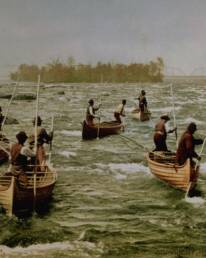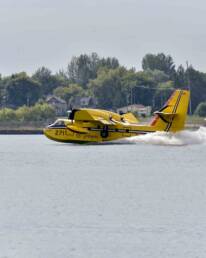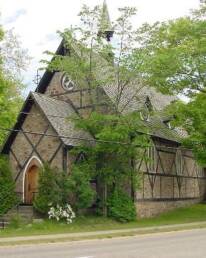Sault Ste. Marie
Sault Ste. Marie is forever linked to its river, “Bawating” or “place of the rapids”, named by The Ojibwe people. Even French colonists, when they arrived in the 17th century, called the area “Saults de Sainte-Marie”, translated to “St. Mary’s Falls”, again after the spectacular rushing waters. Much of your cultural experience in town can take place along its banks, with galleries, museums and street art rolling along the river. And beyond the city’s limits, with the river situated as a natural highway into the Great Lakes and the ‘further north’, it’s no surprise that the Soo and its river have thrived together.
Day One
STROLL THE SCULPTURE PARK & ART GALLERY OF ALGOMA – 10:00 AM
Founded in 1975, the Art Gallery of Algoma has studios, a cafe, and four exhibition spaces. Their collection of nearly 5000 works has a rigorous Indigenous art collection, including work from John Laford and Norval Morrisseau. The gallery also has a large selection from the Group of Seven and Dr. Roberta Bondar. For anyone looking to brush up on their creative skills, the gallery holds various classes and creative workshops throughout the year, including Woodland Style paint classes.
Conveniently located right next door to the Art Gallery of Algoma, the Elsie Savoie Sculpture Park is home to a number of important and eclectic works. Spot an arch composed of leaping dolphins or a totem pole fashioned out of used car parts. And feel the sense of community while you stroll, even in its namesake: the park was named after a devoted volunteer and early supporter of the Art Gallery of Algoma.
Feeling hungry after your gallery visit? Walk over to nearby Queen Street to take in all the fine culinary fare on offer. We hear that Tandoori Garden has the best curry in town!
SAULT STE. MARIE MUSEUM — 1:30 PM
TAKE IN THE HISTORY OF THE SOO
After your lunch break, head over to the Sault Ste. Marie Museum, which is located in an old Edwardian post office. The museum chronicles the history of the Soo, from when the ancestors of the Ojibwe people first walked along its shores, through to French and British colonization, and into the present day.
The museum’s three floors are full of galleries, displays, and vignettes, including the Walter Wallace Military Gallery, the Sports Hall of Fame, and the Discover Gallery where kids can get hands on.

THE ERMATINGER CLERGUE NATIONAL HISTORIC SITE & OLD STONE HOUSE — 3:00 PM
A slice of 19th century life awaits you at this National Historic Site. Here you’ll find some of the oldest stone buildings in Ontario, which were built for notable fur trader Charles Oakes Ermatinger, and later housed the American industrialist Francis Hector Clergue. Both Ermantinger and Clergue were instrumental in building up industry and infrastructure in the area, allowing the Soo to grow into the commercial hub that it is today.
Stroll through the historic chambers of the Old Stone House and the Blockhouse, or wander its gardens, where period-specific produce and flowers are grown. You can visit the nearby Heritage Discovery Centre to take an interactive tour of 19th century Sault Ste. Marie.
SOAR AT THE BUSHPLANE CENTRE — 3:00 PM
Your final of three options for an afternoon museum will have you find your wings! In Ontario’s northern reaches, the bush plane is vital, enabling shipping and transportation across vast distances.
At this museum, take in dozens of bush planes from across decades. Relax in the theatre and learn about battling forest fires in Ontario, from the air and on the ground, or hop in the Flight Adventure Simulator and experience the unique aerial views of Sault Ste. Marie and Algoma.

TAKE THE SCENIC ROUTE — 5:00 PM
WIND DOWN WITH A TRIP ALONG THE HUB TRAIL
Sault Ste. Marie is a city with a view, so put on a comfortable pair of walking shoes or grab a bike, and head down the Hub Trail. The trail circumvents the entire city, including a wonderful portion running along the waterfront. It’s a great way to see the river and its American sister city of the same name, Sault Ste Marie, Michigan, across the water. If you’re keen to take a more casual route, the boardwalk also offers a fantastic view and includes a few spots to stop and look at the river.
Either way, you’ll eventually find your way to the Canal National Historic Site, where you can watch ships cruise by or learn about the history of the locks.
Just across the canal is White Fish Island, a popular spot for a leisurely stroll or a beautiful sunset walk. Here, you can take a self-guided, 2-hour tour to learn about Indigenous heritage and culture. This has always been a place of importance for the Ojibway: Elders from Batchawana share that when the Creator told the crane to choose a homeland, he flew in search of it and settled in Bawating. Currently a gathering place for the Three Fires Confederacy between the Ojibway, Potawatomi, and Odawa Peoples. While you’re there, look out for the interpretive signs to learn more of this history!
This walking tour will have you work up an appetite right before dinner – for a late evening bite choose between Chinese, Italian, Thai, and Middle Eastern.

Day Two
AN ADVENTURE OUT OF THE CITY — 10:00 AM
PADDLE, PAINT, AND TREK WITH THRIVE TOURS
Connect to nature on a guided adventure by either canoe, kayak, hiking, or snowshoeing. Whether you’re a beginner or experienced, Thrive Tours is has an option for anyone looking to enjoy nature or learn to kayak. Their outings range from a half-day, 2-hour excursion to a full 6-hour trek. We recommend the tours featuring Indigenous ecology philosophies as well as the Woodland Style paint-and-paddle workshop. Inquire online ahead of time, as pre-registration is required.
For a quick bite on your way back into town, choose Chummy’s Grill. Home of an “All Day Breakfast” and renowned burgers and home cut fries. Don’t miss their ‘R Smokin Store’ drive-thru, which is open 7 a.m. to midnight, 365 days a year.
THE OLD CHAPEL AND THE SHINGWAUK CENTRE — 2:00 PM
EXPLORE IN THE EAST
Take in the farther out city spots in the east end. Head to the Bishop Fauqier Memorial Chapel and the neighboring Shingwauk Centre. The Gothic- and Tudor-style chapel (constructed between 1881 and 1883) is named after the first Anglican Bishop of Algoma, and was built to service the Shingwauk Residential School, which ran until 1970.
The University of Algoma took over the site of the residential school and over time has worked to research, document and share the history of the residential school program. You can go for a tour at the Shingwauk Residential Schools Centre or visit the archives to learn more about the lives of survivors.

THE SOO'S HISTORIC NEIGHBOURHOODS — 4:00 PM
Still in the east, you’ll find a handful of blocks that contain some of Sault Ste. Marie’s most charming homes, storefronts and hotels. Wander the streets and you’ll see lovingly- restored examples of Georgian, Victorian and Edwardian architecture.
For the final stop on your journey, it’s time to turn your gaze to natural delights. Bellevue Park has an abundance of flora and fauna to explore, as well as a greenhouse full of decorative blooms. If you want to get a little closer to the water, walk across the small land bridge to Topsail Island and check out its miniature beach. This is the perfect place for a final sunset to end your trip to the Soo.
HAVE TIME FOR A DETOUR?
Looking to explore a little further afield? Sault Ste. Marie is a major hub for outdoor exploration, and with a twin sister city across the river, there’s plenty to do if you’re looking to extend your northern adventure.
AGAWA CANYON & PICTOGRAPHS
Located to the far north of Sault Ste. Marie, these ancient trails house some of the oldest Indigenous art in the country: the famed Pictographs of Agawa.
YOUR TRIP AT A GLANCE
SEE
Sault Ste. Marie Public Library – James L. McIntyre Centennial Library
Elsie Savoie Sculpture Park
Art Gallery of Algoma
Sault Ste. Marie Museum
Sault Ste. Marie Hub Trail & Boardwalk
Sault Ste. Marie Canal National Historic Site
Ermatinger Clergue National Historic Site & Old Stone House
Canadian Bushplane Heritage Centre
Thrive Tours
Sault Ste. Marie Heritage Neighborhoods
Bellevue Park
Bishop Fauquier Memorial Chapel & Shingwauk Centre
EAT & DRINK
Chummy’s Grill
NEED A MAP?
Charge into adventure! Electric vehicle drivers can explore Ontario with ease thanks to Ivy Charging Network stations located throughout the province.
This guide represents a weekend-long experience, highlighting one of the many wonderful destinations in the area. To suggest a destination for a future guide, please contact us.
All editorial decisions were made at the sole discretion of Ontario Culture Days staff. This guide was written by Li Robbins.


